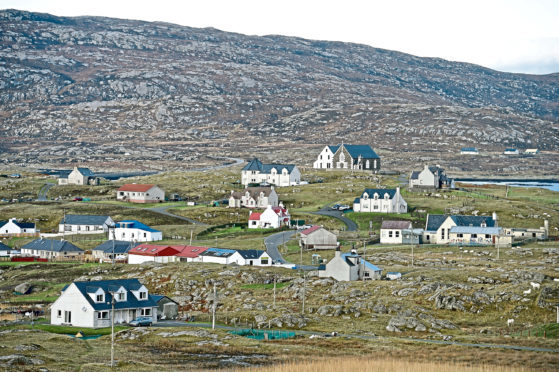A new phrase was coined by the head of Highlands and Islands Enterprise last week to describe the region’s most pressing problem.
Without any shadow of a doubt, said Charlotte Wright, the biggest challenge facing the north was the “people equation”.
Essentially, the conundrum is that there are opportunities for the local economy to grow, but there are not enough workers to meet the demand.
And in some areas, particularly communities in parts of the Western Isles and Argyll and Bute, the issue was actual population decline.
That the spectre of depopulation is back at the top of the agenda for HIE and others should be, as Ms Wright told a Holyrood committee, a “great cause for concern”.
Because the “people equation” will be depressingly familiar to many as simply a variation on the original “Highland problem”, which Ms Wright’s own predecessors on the Highlands and Islands Development Board (HIDB) were tasked with fixing five decades ago.
The progress made since then, in halting and beginning to reverse more than a century of depopulation, has been a remarkable and under-appreciated success story.
The addition of nearly 100,000 residents – a rise of more than 22% since the mid-1960s – has meant that younger generations in parts of the region have been able to grow up with little awareness of the existential threat once faced by their communities.
The fear, now, is that the next generation might not be as lucky.
However, the reality is that the recovery was always imbalanced and the Highland problem never really disappeared.
While new industry arrived in Easter Ross and Inverness famously became “Europe’s fastest growing city”, the Outer Hebrides lost 10.5% of its population between 1991 and 2001, and experienced an overall 43% decline between 1901 and 2001, before rebounding modestly by 4.5% between 2001 and 2011.
With deaths outstripping births, the Western Isles are now expected to lose another 14% by 2039, with Argyll and Bute facing an 8% drop.
The consequences of this adjustment could be dramatic as stretched local authority services, which are funded on the basis population and their tax base, collapse, and accelerate a “spiral of decline” in the process.
Scottish ministers are of course aware of the looming crisis, and have focussed their efforts on battling the UK Government over control of immigration.
Westminster’s Migration Advisory Committee (MAC) dismissed their plea for powers to attract more foreign workers last month, however, on the grounds that “some northern English regions have similar prospects”.
In fact, no English region faces a population decline in the next decade, and just four of the 353 council areas south of the border are predicted lose as many residents as the Western Isles and Argyll and Bute.
The MAC also said that, instead of immigration, Scotland could focus on the “reasons for locals leaving”. It was a derisory response to a legitimate demand, of course, but it is true to say that attentions must again be turned to the root of the problem.
HIE, which succeeded HIDB and continues its work, recently helped to secure investment for the UK’s first spaceport in Sutherland and Britain’s only alloy car wheel manufacturer in Fort William. But its hands have increasingly been tied by diminishing budgets and attempts to centralise its control.
Local authorities, too, are alive to the issue, while the work of community ownership groups such as Stòras Uibhist has been invaluable. But where are the action plans and long-term vision from those with real power at Holyrood and Westminster?
The depopulation tide was turned before through bold governmental interventions such as the creation of the HIDB and the establishment of the area’s own university, but today they bicker between themselves about Brexit and broadband investment.
It is obviously a complex and time-consuming task, involving perennial problems which are not easily solved.
But there must be initiatives that can have a direct and immediate impact as well.
Of the 7,916 staff working in the Scottish Government’s core directorates and most executive agencies, just 270 are based in the Highlands and islands.
Is it not time to revisit the Labour-led Scottish Executive’s previous policy of distributing civil service jobs away from the central belt?
Why, for example, is the headquarters of ferry operator CalMac based in Gourock and not Oban or Stornoway?
Perhaps these lifeline services would also improve if those in charge had to rely on them on a daily basis. Equally, there is surely no necessity for the likes of Marine Scotland, Historic Environment Scotland and VisitScotland to all be based in Edinburgh.
The public sector job trend in recent years, however, has been in the opposite direction.
The looming closure of Fort George will leave the Highlands without an active military base, the region’s police and fire control rooms have been shut down, while Highland Council’s workforce has been cut by 21% since 2009 and Western Isles Council by 16%.
Progress on land reform has been welcome, meanwhile, but more radical calls for action have not been backed, such as Community Land Scotland’s recent bid to use compulsory purchase powers to repopulate townships wiped out during the Clearances.
“Imagination, patience and persistence,” was prescribed by then Scottish Secretary Willie Ross as he tasked HIDB with resolving the “Highland problem” in 1965.
Half a century later, there has been plenty of patience, but the need for imagination and persistence has rarely been more relevant.
Because whether it is X policy or Y, Highlanders with long memories know this is not an equation that will solve itself.

